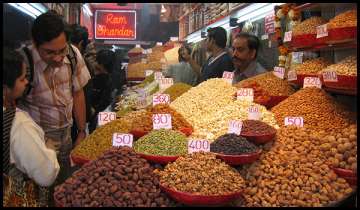Wholesale inflation broke the 3-month declining trend and rose to 3.39 per cent in December 2016, mainly due to rise in prices of manufactured items, even as food articles turned cheaper.
The wholesale price index-based inflation, reflecting the annual rate of price rise, in November stood at 3.15 per cent. In December 2015, the print was (-)1.06 per cent.
WPI inflation in vegetables, at (-)33.11 per cent in December, saw deflationary pressure for the fourth consecutive month. This was helped by a substantial price fall in onions, which stood at (-)37.20 per cent.
Pulse inflation continued to rule high at 18.12 per cent in December, according to commerce ministry data.
Potato recorded maximum inflationary pressure at 26.42 per cent. Rate of price increase in egg, meat and fish was 2.73 per cent during the month.
Overall, the food inflation basket witnessed contraction, with inflation at (-)0.70 per cent in December as against 1.54 per cent in November.
Inflation in fuel and power and manufactured items saw some uptick, which pushed up the overall WPI inflation in December.
The reading for manufactured articles was 3.67 per cent compared with 3.20 per cent in the previous month. Inflation in the fuel and power segment was 8.65 per cent in December, up from 7.07 per cent in November.
hile the rate of price rise in sugar was 28.04 per cent, for petrol, it was 8.52 per cent, and 20.25 per cent for high speed diesel.
The WPI inflation for October has been revised upwards at 3.79 per cent against the provisional estimate of 3.39 per cent.
The decline in wholesale inflation is in contrast to the fall in retail inflation, which hit a three-year low of 3.41 per cent in December.
The monetary policy committee headed by RBI Governor Urjit Patel had last month held interest rates steady and said demonetisation of high-value currency notes could lower prices of perishables and reduce CPI inflation by 10-15 basis points by December.
RBI has projected March 2017 CPI inflation to be 5 per cent.
PTI inputs
Latest Business News
